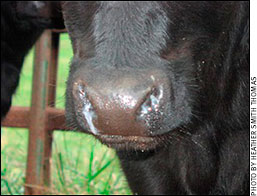Summer Pneumonia in Calves
Study is searching for answers about summer pneumonia.
Pneumonia (infection in the lungs) can affect calves of any age. Most of the bacterial pathogens that cause pneumonia are already present in the calf’s upper respiratory tract. They become a problem in the lungs only when the calf’s immune defenses are compromised, such as by viral infections or stress. Stress may be due to bad weather; extreme changes in temperature; a long truck haul; overcrowding in a dirty environment; or nutritional stress due to deficiencies of an important mineral, such as copper (Cu) or selenium (Se).
One of the most frustrating respiratory infections in nursing calves has been called “summer pneumonia.” The cause is not always easy to determine — especially since cases tend to appear during good conditions when we don’t think of these calves as being stressed.
Russ Daly, extension veterinarian and associate professor at South Dakota State University (SDSU), has been working with a study comparing ranches that have experienced this problem in calves with other ranches in the same regions that have not had the disease.

The cause of summer pneumonia is not always easy to determine — especially since cases tend to appear during good conditions when we don’t think of these calves as being stressed.
“This is a syndrome I have been interested in ever since I was in private practice in southeastern South Dakota. We know a lot more about weaning-age and postweaning respiratory disease in calves and how to prevent and treat it. In postweaning pneumonia, if we can minimize the animals’ stress levels and do a good job of vaccinating, we can expect to see fewer problems,” he says.
“The frustrating thing with summer pneumonia in younger [preweaned] calves is that even though we think we are reducing their stress and providing what we think are good vaccination programs, it’s not working to prevent the disease as uniformly as it does for the postweaning respiratory problems. Our study is trying to find some answers,” says Daly.
“In our study we looked at a large number of farms that have had cases and compared them with farms that haven’t had issues — in a similar geographic location and period of time. We want to see if we can discover the factors that make things more favorable for the health of these calves on some farms or find anything that could help cattle producers prevent this disease,” he says.
In some cases the calves are getting sick on summer range and not being stressed by human interference, he notes. “We don’t have a good handle on what’s happening. We can understand the stress of transport, weaning, dusty corrals, etc., but oftentimes this is different.”
Researchers are looking at gathering cows and calves when doing artificial insemination (AI)-heat synchronization programs.
“We want to look at the dynamics in that situation, when we’ve taken the calf away from its mother. It’s usually a very short period of time and we wouldn’t think it could be enough stress to affect the calves, but maybe this affects the transmission of bacteria or viruses,” he says.
“We know that diseases like scours are often multi-factorial. It’s more than just the bug and the animal; there are usually more things going on that predispose that calf to getting sick. Summer pneumonia may be multi-factorial also. Colostrum intake has been looked at, along with calves’ ability to respond to vaccine at different ages,” says Daly.

Editor’s Note: Heather Smith Thomas is a freelancer and cattlewoman from Salmon, Idaho.





